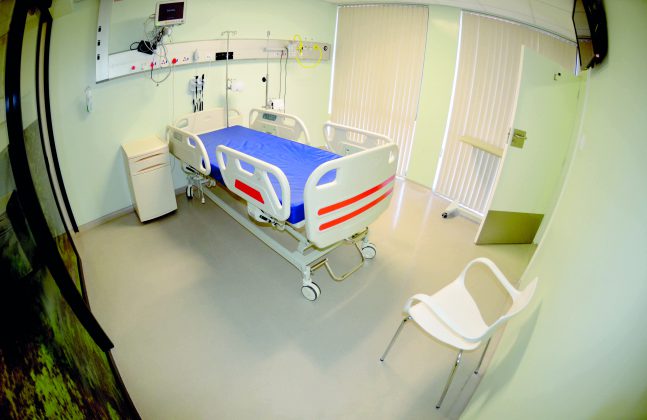A recent report by a health service financial watchdog claimed that there are almost 250,000 falls in the UK’s hospitals every year! The report concluded that this had involved at least 250 incidents where patients had died and resulted in an overall cost to the NHS of £630 million a year.
Despite the guidance on falls having been updated only four years ago, this news has led to calls from NHS chiefs for more work to be done to prevent injuries from falls.
The 2013 guidance from the National Institute for Health and Care Excellence (NICE) recommended that hospitals carefully consider a number of factors to ensure that patients aren’t put at risk of dangerous slips and trips. These factors included not just the age of the patient and their medical condition but also the impact that unfamiliar surroundings, flooring, lighting, furniture and fittings can have.
NICE estimates the total cost of falls to be £2.3 billion, with hospitals accounting for roughly a quarter of that. A calculation by NHS Improvement reckons that reducing inpatient falls by 25-30% could result in a saving of £170 million a year!
As the report emphasised, much of this cost is to do with the fact that falls have longer term consequences than many realise, as it often means that patients require a longer stay in the hospital, could suffer brain damage, disabilities or potentially even die.
The floor plays an obvious role here – as if it is wet, cracked and slippery then it is little more than an accident waiting to happen! This is why hospital operators should carefully consider the properties that the floor requires, the challenges that it will face and how it can be tailored to help patients stay on their feet.
Anti-Slip Flooring
In areas where still water is likely to be present during normal daily operations and where standard footwear is being worn it is advisable to install a friction filled non-profiled material with macro-roughness (roughness comprising an aggregate).

A high level of slip resistance can be created by incorporating large aggregates into a polyurethane coating.
The adaptability of resin flooring solutions enables hospitals to alter the levels of traction underfoot so as to best match the competing demands of cleanability and slip resistance in each part of a hospital. This is achieved by tailoring the quantity and size of aggregate incorporated into the resin finish.
Resin floors provide hospital designers with the ability to create ultra-rough surfaces made from polyurethane and large aggregates that really grip onto the sole of the shoe at one end of the spectrum to exceptionally smooth but robust systems that can be laid to a very precise surface regularity at the other end.
This versatility means that the floor’s smoothness can be increased in areas where fast cleaning is a priority and conversely where slip resistance is key the floor can be given a rougher texture.
The slip resistance of a floor can be ascertained through assessments such as the Wet Pendulum test to check that the finish meets the system’s stated anti-slip properties. The floors non-slip potential should be checked over time, as wear, contamination and cleaning can all make a surface slipperier than it should be.
Easy Cleaning Properties
Effective drainage and the removal of water is not only important for sanitation, but it will also help to remove dangerous slip hazards. Impermeable surfaces with coving make it easy to clear water, spillages and unwanted liquid out of the area before it can become either a hygiene or slip risk.

A seamless, level epoxy resin finish is ideal for creating large expanses of easy to clean flooring, free from cracks and gaps that can constitute a trip hazard or where contaminants can accumulate.
The durability of the floor is an important factor to ensure that the finish maintains its easy cleaning properties, as if it cracks and starts to fail it will quickly become difficult to clean and could even introduce a new trip hazard!
Colour and Design
Each person’s cognitive senses, motor skills and personal situation can influence the risk of slips and falls. The most vulnerable groups include the aged, children and the disabled, elderly people are at a particularly high-risk as any falls could cause further complications. In fact, the recent NHS report highlighted that three quarters of falls involved patients aged over 65 even though only two fifths of patients fit into that category.
To help these vulnerable groups the floor can be applied in bright, light reflective surfaces that will help those moving around the site to see where they are going. This will also make any dropped contaminants easily visible, helping pedestrians to avoid stepping in them and also helping staff to identify spots in need of cleaning.
Any change of floor surface should also be clearly identified to reduce the chance of tripping. The seamlessness of a resin finish helps to avoid the gaps and changes in level inherent to flooring materials such as tile and carpet.
As ‘unfamiliar surroundings’ was one of the key factors picked up on by the report, flooring design elements should be utilised to help acclimatise patients to their new surroundings. Colours and patterns in the floor can be used for this purpose, such as by designating different zones and by creating navigational signage that helps patients, staff and visitors find their way around the building. Practically, the less time people spend moving then the less chance they have of experiencing a dangerous fall.

The Kwazulu-Natal Research Institute for Tuberculosis and HIV used colour zoning extensively, like in this example where spaces for equipment are marked out in bold colours and a safe route for pedestrians is clearly visible thanks to the cream-coloured band of flooring.






1 thought on “How Floors Can Minimise Falls in Hospitals”
Comments are closed.